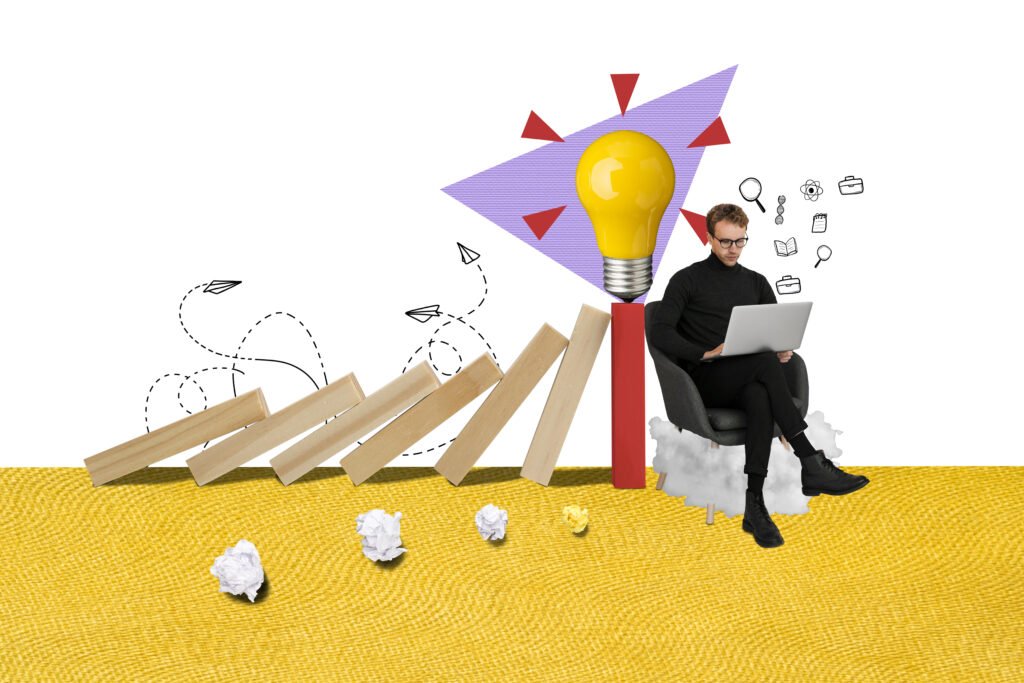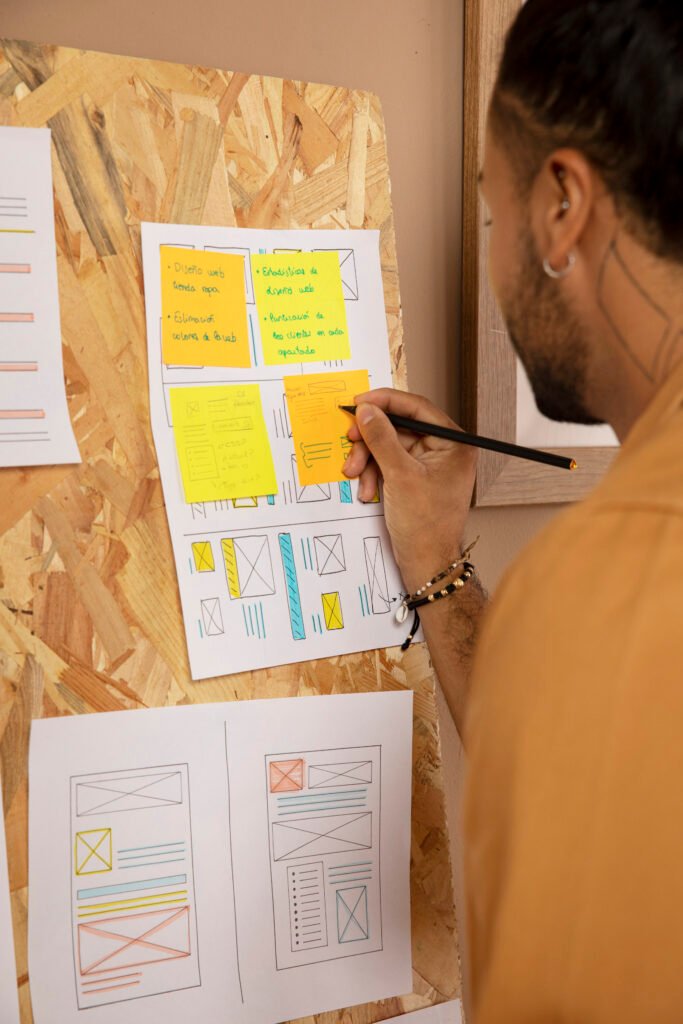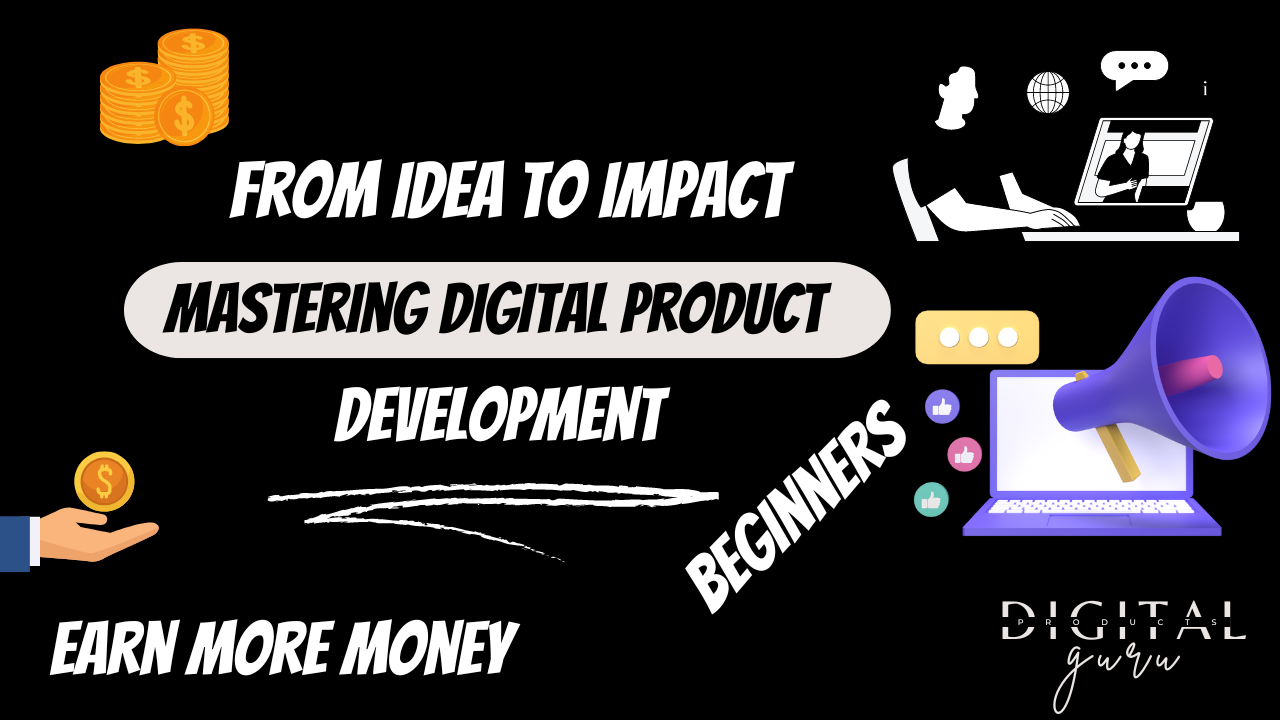In today’s fast-paced digital age, the process of product development has become a cornerstone for companies looking to innovate and capture market share. At the heart of successful digital products lies a complex journey from the initial idea to the final product launch. This journey is shaped by rigorous market research, the art of idea generation, and the strategic orchestration of product development processes. Whether you’re a seasoned product manager or an aspiring entrepreneur, understanding the product development lifecycle is crucial. Let’s delve into the blueprint of transforming a vision into a tangible product that resonates with your target audience.
Table of Contents
1. Understanding the Basics of Product Development :

Product development is the lifeblood of innovation and market growth, serving as a bridge between a mere idea and a tangible product that meets the needs of its target audience. Let’s explore the foundational elements of the product development process:
Certainly! Let’s dive into the ideation phase of product development, where creativity and strategic thinking come together to shape innovative solutions. Imagine a cozy coffee shop, where ideas percolate like freshly brewed coffee.
2. Ideation: Brewing Creative Solutions

The Coffee Shop Scenario
Picture this: You’re sitting in a charming coffee shop, surrounded by the aroma of freshly ground beans. The sun streams through the window, casting warm light on your notebook. Your team members gather around, each with their favorite mug in hand. It’s time for ideation.
- Brainstorming: The room buzzes with energy as ideas flow freely. You jot down everything—wild, practical, and quirky. No judgment here! Maybe someone suggests a wearable device that tracks stress levels by analyzing heart rate variability. Or perhaps it’s an app that connects lonely bookworms based on their favorite genres. The key is to generate a plethora of ideas.
- Storyboarding: Now, let’s add a dash of creativity. Imagine a storyboard—a visual narrative that unfolds like a comic strip. You sketch scenes: a frustrated commuter stuck in traffic, a light bulb flickering above their head, and voilà! The idea for a carpooling app that matches people based on their routes emerges. Storyboarding helps you visualize the user journey and identify pain points.
- Empathy Mapping: Human touch matters. You put yourself in the shoes of potential users. What keeps them awake at night? What delights them? You create an empathy map—a canvas with quadrants for thinking, feeling, saying, and doing. Maybe your target audience thinks, “I wish I could find healthy recipes for picky eaters.” Bingo! A personalized meal planning app takes shape.
- User Personas: Meet Sarah, a busy working mom who juggles deadlines and soccer practice. And there’s Alex, the eco-conscious college student who dreams of reducing plastic waste. You create user personas—detailed profiles of your ideal users. Sarah needs a time-saving home organization app, while Alex craves a zero-waste shopping guide. These personas guide your ideation.
The Art of Curating Ideas
But wait, there’s more! Ideation isn’t just about quantity; it’s about quality. Here’s how you curate those coffee-fueled ideas:
- Divergent Thinking: Like a kaleidoscope, twist and turn your ideas. Combine them, remix them, and explore new angles. Maybe the stress-tracking wearable could also play soothing music. Diverge before you converge.
- Prioritization: Not all ideas are equal. Some are espresso shots—bold and impactful. Others are herbal teas—gentle but comforting. Use techniques like the MoSCoW method (Must-have, Should-have, Could-have, Won’t-have) to prioritize. What’s non-negotiable? What’s a nice-to-have?
- Validation: Step outside the coffee shop. Talk to potential users. Conduct surveys, interviews, and focus groups. Validate your ideas. Does the world need another meditation app? Or is there room for a meditation app that combines mindfulness with cat videos? 🐱
3. Market Research: Unveiling Insights

Picture this: You’re sitting across from your team, notebooks open, pens poised. The air is charged with anticipation. Your product idea is like a freshly brewed cup of coffee—rich, aromatic, and full of potential. But before you take that first sip, let’s explore the essence of market research:
- Understanding Customer Needs: Just like a barista customizes a latte to suit individual tastes, market research helps you understand what your potential customers crave. Who are they? What problems keep them up at night? Dive deep into their desires, fears, and aspirations. Conduct surveys, interviews, and focus groups. Listen attentively, like a coffee connoisseur savoring every note.
- Competitive Landscape: Imagine the cafe bustling with other coffee shops. Each has its unique blend and loyal patrons. Similarly, your product operates in a competitive ecosystem. Research your rivals—their strengths, weaknesses, and secret ingredients. What sets your product apart? Perhaps it’s the extra shot of innovation or the foam of exceptional customer service.
- Market Trends: Just as coffee trends evolve (remember when cold brew became all the rage?), markets have their own ebb and flow. Scan the horizon for trends—technological shifts, cultural movements, and emerging behaviors. Are people leaning toward sustainable solutions? Are they craving convenience? Adapt your product to ride these waves.
Crafting a Market Plan
Now, let’s brew our market plan—a blend of strategy and intuition:
- Segmentation: Imagine sorting coffee beans by flavor profiles. Similarly, segment your audience. Are you targeting busy professionals who need time-saving apps? Or eco-conscious millennials seeking sustainable products? Each segment deserves a tailored approach. Remember, a cappuccino lover won’t settle for a plain drip coffee.
- Positioning: Think of your product as a signature drink on the cafe menu. How do you want customers to perceive it? Is it the bold espresso shot for risk-takers or the soothing herbal tea for wellness enthusiasts? Craft a compelling positioning statement. It’s like describing latte art—precise, enticing, and memorable.
- Pricing and Distribution: Pricing is like choosing between a single-origin specialty or a budget-friendly blend. Research pricing models—cost-plus, value-based, or freemium. Where will your product be available? Online platforms? Retail shelves? Cafes? Map out your distribution channels. Remember, accessibility matters.
The Human Touch
Market research isn’t just data—it’s empathy. It’s understanding the nuances, like appreciating the subtle notes in a pour-over. As you sip your coffee, think about your potential customers—their morning routines, their digital habits, their pain points. Blend your intuition with insights, and soon, your product will be more than a concept—it’ll be a delightful brew for the masses.
4.Design and Prototyping: Digital Product Development

Imagine this: you have a brilliant idea for a digital product, an app that revolutionizes grocery shopping, a website that connects dog walkers with busy pet parents. But how do you bridge the gap between that spark in your head and a real, usable product? That’s where the magic of design and prototyping comes in.
Design: The Blueprint for Innovation
Think of design as the architect of your digital world. It’s about understanding your users, their needs, and their desires. It’s about sketching out the flow of your product, where users click, swipe, and tap. It’s like creating a blueprint, but instead of bricks and mortar, you’re using user empathy, logic, and a dash of creativity.
Here’s the human touch: design isn’t just about pixels on a screen. It’s about putting yourself in your users’ shoes. Picture them scrolling through your app on the bus, tapping buttons with one hand while holding a latte in the other. Design helps you anticipate their needs and frustrations, crafting an experience that feels intuitive and delightful.
Prototyping: From Sketch to (Almost) Reality
Now, design gives you the roadmap, but prototyping lets you actually walk the path. A prototype is a tangible representation of your product, a way to test the waters before diving in headfirst. It can be as simple as a cardboard box with buttons drawn on or a basic website built with drag-and-drop tools.
The beauty of prototyping is its low-fidelity nature. Think “duct tape and cardboard” instead of polished perfection. It allows you to get feedback early and often from real users. They can interact with the prototype, see if things flow logically, and point out any confusing elements.
This human interaction is key. Imagine the joy of seeing a user’s face light up when they discover a cool feature in your cardboard prototype. It validates your design choices and fuels the fire of innovation.
The Human Touch: Collaboration is King
Here’s the secret sauce: design and prototyping are most powerful when done collaboratively. Gather your team, your target audience (even grandma can be a valuable tester!), and get their feedback. Brainstorm, iterate, adjust. The best digital products are born out of this messy, human-centered dance.
So, the next time you have a digital dream, don’t let it stay trapped in your head. Grab some cardboard, unleash your creativity, and get prototyping! It’s the perfect way to bring your idea to life, with a little human touch along the way.
5.Development:

We’ve poured our hearts into the design, crafted a captivating prototype, and now it’s time for the grand reveal: development! This is where the dream becomes reality, where lines of code morph into a functioning app or website. But development isn’t some solitary confinement in a basement coding cave. It’s a collaborative effort, a symphony of passionate minds working together to bring your vision to life.
Building the Dream Team:
Imagine a bustling construction site, but instead of hammers and bricks, we have keyboards and lines of code. Developers, engineers, and coders form the core team, each with their own unique skillset. Developers translate the design into code, engineers build the infrastructure to support it all, and coders weave the magic that makes everything function seamlessly.
The Human Touch: Collaboration is Key
But development isn’t just about individual skills; it’s about teamwork. Think of it like a high-fives-filled game of digital Jenga. Developers work closely with designers, ensuring the code reflects the intended user experience. They collaborate with testers, who act as quality control inspectors, identifying potential cracks in the digital foundation before users encounter them. Communication across these teams is essential. Just like a construction crew needs constant communication to avoid building mishaps, developers rely on clear communication to keep the project on track.
Agile: Building in Bursts, Not Brick by Brick
Forget the slow, monolithic approach of traditional development. We embrace the power of Agile methodologies. Think of it as building in sprints: short, focused bursts of activity where we tackle key features. This allows for continuous adaptation. We prioritize features, develop a Minimum Viable Product (MVP) – a basic version with core functionalities – and then gather real-world user feedback. This feedback becomes the fuel for our next sprint, allowing us to iterate, refine, and make the product even better.
The Art of Efficiency: Avoiding Bottlenecks and Pizza Breaks
Efficiency is key. We utilize tools like continuous integration, where code changes are automatically merged and tested frequently. This helps identify and squash bugs early on, preventing them from becoming major roadblocks. But development isn’t just about heads-down coding. Collaboration thrives on a healthy dose of human connection. Those pizza breaks and high-fives aren’t just fun; they foster strong team spirit and help maintain clear communication. A happy team is an efficient team, after all.
The Final Note: From Code to Creation
Development is the heart of bringing your vision to life. It’s about developers, engineers, and coders working together, fueled by coffee, collaboration, and a shared passion for creating something amazing. It’s the bridge between the spark of an idea and a fully functioning digital product. So the next time you use a flawless app or experience a website that feels effortless to navigate, remember the human touch behind the code. It’s a testament to the power of teamwork and the dedication of those who translate the dream into reality, line by line.
6.Testing and Quality Assurance

We’ve meticulously built our digital masterpiece: the app or website that embodies your vision. But before we unleash it on the world, there’s one crucial step: Testing and Quality Assurance (QA). These vigilant watchdogs, with a keen eye and a surprisingly soft touch, ensure your product is polished, bug-free, and delivers an amazing user experience.
The Testers: Champions of the User Experience
Imagine a team of detectives, meticulously examining every nook and cranny of your product. Testers are the user experience (UX) champions, putting themselves in the shoes of real users and exploring every possible interaction. They click every button, navigate through every page, and try to break everything they can (in a controlled way, of course!).
The Human Touch: Empathy is Key
This is where the human touch comes in. Testers aren’t just robots running automated scripts. They have empathy, the ability to understand how real users might interact with the product. They anticipate user confusion, identify clunky interfaces, and root out any hidden gremlins lurking in the code.
Beyond Bugs: The Art of Quality Assurance
QA is more than just bug hunting, though that’s certainly a crucial part. It’s about ensuring the overall quality of the product. Performance testing ensures the app runs smoothly even under heavy user loads. Usability testing verifies the product is intuitive and easy to navigate. Accessibility testing guarantees everyone, regardless of ability, can enjoy the experience.
Collaboration is King: Working with the Developers
Testers aren’t lone wolves. They work hand-in-hand with developers, forming a collaborative bond. Testers report bugs, and developers fix them. It’s a constant back-and-forth, a gentle tug-of-war that ensures the final product is top-notch.
The Satisfaction of a Flawless Product
The reward for testers and QA professionals? The quiet satisfaction of a flawless product. It’s knowing that their keen eye and meticulous efforts have resulted in an app or website that users will love. They’re the unsung heroes, the watchdogs with soft paws, ensuring our digital masterpiece delivers on its promise.
The Final Note: Building Trust with Every Test
Testing and QA are the final guardians before your product goes live. They build trust, not just for the user but also for you. By ensuring a polished, user-friendly experience, they give your product the best possible chance to succeed. So, the next time you use an app that works perfectly or a website that feels intuitive, remember the testers and QA professionals behind the scenes. Their dedication and human touch have paved the way for a seamless digital experience.
7. Launch and Deployment : Digital Product Development

The moment of truth has arrived! We’ve meticulously designed, prototyped, developed, and tested your digital product. Now it’s time to unleash it on the world: Launch and deployment! This stage is a culmination of all the hard work, a mix of nervous anticipation and exhilarating excitement.
The Launch Pad: Planning for Lift-Off
Imagine a bustling launch control center, buzzing with activity as we prepare for our digital product’s liftoff. The launch team meticulously plans every detail, from deployment on the appropriate platform (app store, website, etc.) to crafting a captivating marketing message. Think of it as the final countdown – every step needs to be precise and well-coordinated for a smooth and successful launch.
The Human Touch: The Power of Storytelling
But launching a product isn’t just about technical logistics. It’s about storytelling. The launch team crafts a compelling narrative that resonates with your target audience. They highlight the product’s benefits, showcase its unique features, and create a sense of excitement around its potential. It’s the human touch that ignites interest and compels users to give your product a try.
Deployment Day: A Symphony of Teamwork
Deployment day itself is a whirlwind of activity. Developers meticulously push the final code, ensuring a seamless rollout. Marketing and PR teams unleash their carefully crafted messages, generating buzz across various channels. Customer support prepares to answer any user questions and troubleshoot any unexpected issues. It’s a symphony of teamwork, everyone playing their part to ensure a successful launch.
Learning from the First Steps: The Importance of Feedback
The launch isn’t the end of the story; it’s the beginning of a new chapter. We closely monitor user feedback, analyze user behavior data, and identify areas for improvement. This human connection with your user base is crucial. Their feedback becomes the fuel for future iterations, allowing you to refine your product and ensure it continues to meet their evolving needs.
The Joy of Impact: Witnessing Your Dream Take Flight
The ultimate reward for the launch team? Witnessing your digital product take flight. It’s seeing users download the app, explore the website, and discover the value it brings to their lives. It’s the culmination of countless hours of brainstorming, designing, coding, and testing, all coming together to create a positive impact.
The Final Note: A Journey, Not a Destination
Launching a digital product isn’t a one-time event; it’s the start of a continuous journey. By incorporating the human touch – the creativity, collaboration, and empathy – at every stage, you can ensure your product not only launches successfully but also thrives and evolves over time. So, take a deep breath, embrace the pre-launch jitters, and get ready to see your digital dream take flight! The world is waiting to experience it.

